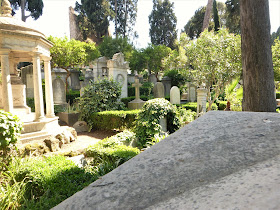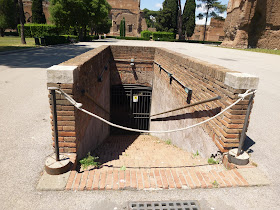A few comments then I'll finish up with summary of "History in One Place" for this week.
Perhaps the carved figure is actually a likeness of Alice Henry Mary, beloved daughter of James and Emma George. She died in Rome in 1879. I read by the way that crosses were not allowed in the Protestant Cemetery until circa 1870. Alice died at age 21. Her epitaph reads "Where the Weary are at Rest".
A simple inscription Bonnouj, presumably a family name. The data base I tried searching required the nationality of the departed. I tried everything that fit...French, Belgian, Moroccan, US, UK. Nothing. The cemetery contains a bewildering diversity of faiths and origins so I eventually gave up.
The grave of Emma Ahlse Severin. She lived a long life, 1844 - 1925. She was German, born in Naples. The inscriptions reads "Here Rests with our Father our Beloved Mother". It might be meant either literally or theologically.
William Joseph Buckley. He died in 1882 at age 36. "Died of Diphtheria after four days of illness". "In the Midst of Life we are in Death". Somewhat cryptic and dour final words.
This week's "History in a Place" sites are all close together and easy to visit. Please also include Monte Testaccio in your itinerary. To visit them all you just need to take the Metro to Pyrimide Station or take any of the numerous buses that go to the Ostiense rail station. You can hardly miss the gate and the pyramid when standing in front of the station.
As I mentioned in an earlier post there is not that much to see at Monte Testaccio but you are in the neighborhood so stroll a few blocks to the south west and have a look. On infrequent occasions they will unlock the gate and allow groups to climb to the top.
The Protestant Cemetery is open every day. They rely on donations so please be generous. 9 - 5 Monday through Saturday, 9 - 1 on Sundays. The entrance is on a back street behind the cemetery. Via Caio Cestio. The entrance is not obvious, so persevere. If you are headed for Monte Testaccio this is probably the street you will be walking on.
At Porta San Paulo there is a little museum inside the gate. Opening hours are listed as 9 - 1:30 every day but Monday. Its free, but it seems a fairly modest little site so don't make a special trip to see it if you have already taken in the larger museum at Porta San Sebastiano.
Visiting the inside of the Pyramid of Cestius is possible but a little complicated. If this interests you HERE is the information.
None of these sites take all that long to visit, and as long as you are right at the train station that goes to Ostia I recommend you hop on and go visit. It's a really cheap ride to a really cool site. We'll go there on our next "History in a Place" and a crowded place it is....






















































